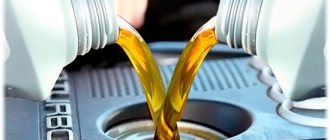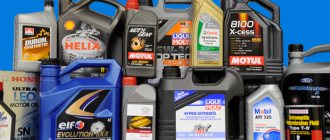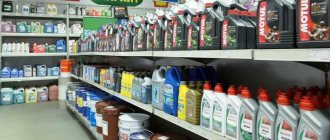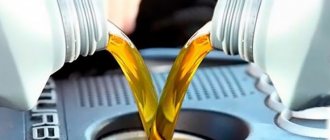Whether it is possible to add another brand of oil to the engine depends on the type of lubricant and the regularity of engine maintenance. During maintenance, the car service center may not have the oil poured on the conveyor, and then they pour an analogue. When the lubricant is drained, a certain amount remains in the system, so mixing of old and new product still occurs. Let's figure out how “mixing” affects the engine, and learn how to mix motor oils correctly.
General rules for mixing motor oils
The rules below can be used as instructions that should be followed if it is necessary to add oil to the power unit, which may differ in manufacturer, marking and type.
Follow these guidelines:
- Do not degrade the quality of the oil. It is prohibited to pour mineral water into synthetic or semi-synthetic oil. The ban also applies to adding “semi-synthetics” to “synthetics”. Deterioration in quality can cause negative reactions and reduce the effectiveness of supplements.
- In a situation where, for various reasons, you had to add poorer quality oil to your car, it is not recommended to heavily load the engine and exceed the speed. You need to move without forcing in order to protect the power unit from damage and extend its life.
- If mixing different oils was unavoidable, as soon as possible it is advisable to drain the resulting composition and refill with new lubricant. In this case, you only need to pour the oil that is recommended by the manufacturer.
- If possible, never mix mineral water and synthetic water, regardless of the manufacturer or other factors. In this case, the additives that were in the synthetic oil lose their effectiveness and precipitate. This feature can cause damage to the motor. Diluting a synthetic product with a mineral one is even more dangerous.
- You cannot fill the power unit with oil of different classes, for example, mix the lubricant of cars and trucks. To do this, you need to know the meaning of engine oil.
- It is not advisable to mix the oil in a 1 to 1 ratio. The maximum volume of added liquid is no more than 15% of the total volume.
- If you can’t find oil from one manufacturer, rely on the tolerances. It is important that they are identical for both products. For example, according to ACEA and API requirements, all oils are very similar in structure and quality. This means that you can mix them with each other and not worry about the result. If the fluid does not meet the standards, it simply will not pass the test. It is important to replace the resulting mixture as quickly as possible.
- If it is necessary to top up lubricant, it is better to use a product from the same manufacturer, albeit with individual viscosity parameters. But pay attention to seasonality. Otherwise, the viscosity of, for example, winter oil can be reduced, which can lead to engine contamination. In addition, when adding oil with a lower viscosity, waste consumption may increase, which requires more frequent level monitoring.
And now in more detail.
How to mix oils
Large manufacturers such as Castrol or Shell provide the required information on the label. It should be written on it that the composition does not contain additives that are incompatible with improving additives from other products. Products from well-known brands are tested, so if you follow the instructions, their use will not harm the engine. But cheap analogues from little-known companies most often do not pass any checks. Therefore, it is important for a car owner to purchase only reliable oils from world brands.
It is necessary to take into account the markings indicating the viscosity of the liquid and its seasonality. It depends on the classification used, the most commonly used is the one adopted in the United States - SAE. The marking of low-temperature or winter variants contains the letter “W”. However, universal oils for any season are more often found on sale.
The name of the classification is always indicated first, followed by a number, for example, SAE 40 or SAE 15W. The higher the number, the stronger the viscosity, and this parameter is higher for summer oils. For all-season lubricants, the first number indicates performance at low temperatures, and the second number indicates performance in warm weather. SAE 20W-40 belongs to the all-season category. Viscosity level markings can be found in the table:
Motor oil viscosity level markings according to SAE
| Marking | Temperature, °C | ||||||||||||||||||||
| -50 | -45 | -40 | -35 | -30 | -25 | -20 | -15 | -10 | -5 | 0 | 5 | 10 | 15 | 20 | 25 | 30 | 35 | 40 | 45 | 50 | |
| All-season | |||||||||||||||||||||
| 0W40 | min | max | |||||||||||||||||||
| 5W30 | min | max | |||||||||||||||||||
| 5W40 | min | max | |||||||||||||||||||
| 5W50 | min | max | |||||||||||||||||||
| 10W30 | min | min | |||||||||||||||||||
| 10W40 | min | max | |||||||||||||||||||
| 15W40 | min | max | |||||||||||||||||||
| 20W40 | min | max | |||||||||||||||||||
| Winter (low temperature) | |||||||||||||||||||||
| 0W | min | max | |||||||||||||||||||
| 5W | min | max | |||||||||||||||||||
| 10W | min | max | |||||||||||||||||||
| 15W | min | max | |||||||||||||||||||
| 20W | min | max | |||||||||||||||||||
| Summer (high temperature) | |||||||||||||||||||||
| SAE 30 | min | max | |||||||||||||||||||
| SAE 40 | min | max | |||||||||||||||||||
| SAE 50 | min | max | |||||||||||||||||||
Kinematic and dynamic viscosities must be in equilibrium. If the balance is disturbed, this leads to the evaporation parameters going beyond. Then, even for products with one base, the additives will not work. The level of dynamic viscosity is measured at 150 degrees, and kinematic viscosity - at a temperature range of 40-+100 degrees. Using these parameters, you can determine the density of the oil film on the surface of the engine elements, which serves as a lubricant. When there is a large distance between the rubbing parts, a film that is too thin can tear. But if the density is high, friction between parts increases.
Differences between synthetic, semi-synthetic and mineral formulations
When considering the issue of mixing different types of oils, it is necessary to understand their characteristics.
Let's briefly look at the main differences:
- “Mineralka” is made from natural oil through selective purification. With proper operation, it can last about 4000-5000 km. It is distinguished by its affordable price and versatility of use.
- “Semi-synthetics” are oils containing artificial and natural components, namely mineral and synthetic types of lubricants. The average service life is 7000-8000 km. Such oils are universal, have high protective qualities and a relatively low price.
- “Synthetics” are the most durable option for motor oils, capable of serving 10,000-15,000 km. The products contain only artificial ingredients. The lubricant is of the highest quality and has a high price. Throughout its service life it shows a high degree of fluidity and viscosity.
As noted, it is not recommended to mix these types of oils due to the possible occurrence of dangerous chemical reactions. The result may be a decrease in service life and deterioration in engine performance.
Combination of different types of oils
Practice shows that in extreme cases, mineral water can be mixed with semi-synthetics and hydrocracking. Mixing mineral and synthetic based oils is also allowed, but under one condition. Synthetics should be based on PAO (polyalphaolefins). There are also opposite cases - when the level of synthetic or semi-synthetic lubricant drops. Then, in case of extreme need, you can add mineral water in small quantities.
Another option is a combination of oils based on the same composition. For example, mineral with mineral, synthetics with PAO with the same. This “cocktail” will work, but it is risky. It is good if the viscosity of both components is the same.
Composition of lubricants
Any engine oil contains a base and additives that ensure the preservation of the necessary fluidity, protection against rust and other useful characteristics.
Each manufacturer uses an individual approach when creating a composition that is reliably protected from competitors.
It is formed taking into account the research conducted, and not only additives are taken into account, but also their ratio.
Often, an increase in the content of one element can cause a decrease in the effectiveness of another additive. This is an important point to remember.
There are often statements on the Internet that manufacturers’ statements about the impossibility of mixing different oils are a hoax, and the main goal is to increase sales.
In fact, the manufacturers themselves do not have experience in mixing different commercial oils; their job is simple: mix the formulations according to the developed instructions; they simply do not have the necessary capacity for other tests.
And the development of oils is carried out by additive manufacturers: Infineum, Lubrizol, Chevron and others.
In practice, products from different companies contain additives with a unique composition. If they come into contact during mixing, the risk of a reaction increases. The latter can be dangerous for the motor.
If we are talking about products from one company, there is a high risk of imbalance of beneficial components in the oil, and this also negatively affects its effectiveness.
In the case of mixing different types of oils, you can only reduce the risk, but it cannot be completely eliminated.
What problems can arise when mixing oils?
A common reason for a decrease in the quality of the mixture is additives; they can react or settle. The reaction occurs due to an imbalance between acidic and alkaline enhancing additives. As a result, the oil may curdle and lose its valuable properties. Corrosion will appear, which will lead to a decrease in engine performance.
Manufacturers are increasingly using highly refined oil and mixing it with additives. But its solubility and ability to retain additives is lower than that of the usual one. If two lubricants that differ in solubility are mixed, the risk of sedimentation increases.
Problems often arise when new oil is added to contaminated used oil. A cloudy precipitate is formed containing peroxide, which is harmful to the engine. It causes oil oxidation and accelerates wear. If the peroxide number is higher than the cleaning ability of the antioxidant, even freshly filled oil liquid, the product may be unusable.
Before filling, it is not enough to simply drain the old oil and flush the engine. It is also necessary to completely clean the oxide deposits. This is the only way to prevent the development of an oxidative reaction. If liquids of different bases are used, foaming is possible. Subsequently, the motor overheats, so it is important to ensure that the bases match.
Possible consequences
Failure to follow the rules for mixing different types of oils can lead to negative consequences.
Let's highlight the main ones:
- Reduced motor life. The incompatibility of additives found in different oils leads to faster wear of the engine, seals and other components that come into contact with the lubricant.
- Deterioration of the properties of motor oil.
- Increasing the viscosity of the lubricant until it coagulates.
To avoid such consequences, it is not recommended to mix different types of motor oils, and when performing such a step, replace them as quickly as possible. Below we will look at several situations in more detail.
Is it worth interfering?
As mentioned earlier, it is impossible to unequivocally answer the question “is it possible to mix motor oils”. It all depends on the properties, parameters, and experts often assure that no terrible consequences can occur from this procedure - after all, the oils are even visually similar to each other? But what if the selected composition produces a reaction that promotes the formation of corrosion and excessive amounts of carbon deposits? Who will bear responsibility for a damaged engine? Automakers, by the way, also do not express any prohibitions on this matter - for them it all comes down to recommendations for choosing a lubricant composition, located in the car manual. Have you selected an oil with the required classification? Great, that means you can pour it under the hood. Everything else depends on the owner himself.
It turns out that in principle there are no documents officially prohibiting the mixing of motor fuels and lubricants. There are only manufacturers' instructions. However, this does not mean that car enthusiasts should constantly mix their motor oils. It is advisable to do this only in cases of extreme necessity. Or if the base oil manufacturer itself allows it. The compatibility of motor oils with other fuels and lubricants is in some cases indicated on product labels. For example, almost all Liqui Moly lubricants contain information about the permissibility of mixing liquids with analogues.
Different manufacturers of the same viscosity
When mixing oils from different manufacturers, the consequences can be no less dangerous than when mixing “mineral water” and “synthetics”. If such a step cannot be avoided, then it is desirable that at least the viscosity be the same. Let's consider different options.
Synthetics of the same viscosity 5W40 and 5W40 from different manufacturers
If you have 5W40 in your engine, but there is no possibility of adding oil from the same manufacturer, you can add oil of another brand with the same viscosity 5W40. The main thing is that these products meet the requirements of ACEA and SAE, because in this case their compositions will be very similar.
| Characteristics | Gazpromneft Premium N | MOBIL Super 3000 X1 |
| Type | Synthetics | Synthetics |
| Viscosity SAE | 5W-40 | 5W-40 |
| API | SN | SN, SL, SM, SJ, CF |
| ACEA | A3/B4 | A3/B3, A3/B4 |
| Engine | petrol, diesel | petrol, diesel |
| For turbocharged engines | + | + |
| Tolerances | MB 229.5, VW 502.00/505.00, Renault RN 0700 / 0710, BMW LL-01, Porsche A40, PSA B71 2296, GM-LL-B-025, JSC AVTOVAZ | AVTOVAZ (Lada cars), Porsche A40, Peugeot/Citroën Automobiles B71 2296, RENAULT RN0700, RENAULT RN0710, VW 502 00, VW 505 00, MB-Approval 229.3, GM-LL-B-025, API CF, ACEA A3 /B3, ACEA A3/B4, API SJ, API SL, API SM, API SN, JASO MA, JASO MA2, AAE (STO 003) Group B6, Fiat 9.55535-M2 |
But there is a nuance. Due to the fact that the oils are made by different manufacturers, there is no guarantee that the same base was used in their creation. For example, synthetic oil can be made using PAO or HC technology.
Consequently, the composition of additives may be different, and this will lead to conflicts between them. The result may be deterioration in the performance of the power unit.
Oils with viscosity 5W30 and 5W40 of different brands
In this case, the risks discussed above remain fully intact. Additionally, viscosity indicators change.
For example, 5W30 at -20 degrees Celsius retains its qualities and is quite viscous, but problems may arise with 5W40.
After mixing, a certain symbiosis occurs, due to which the properties of the oil deteriorate.
| Characteristics | SHELL Helix HX8 Synthetic | MOBIL 1 X1 |
| Type | Synthetics | Synthetics |
| Viscosity SAE | 5W-40 | 5W-30 |
| API | SN, SN+ | SN, SN+, SN+ RC, SN RC |
| ACEA | A3/B3, A3/B4 | A5/B5 |
| Engine | petrol, diesel | petrol, diesel |
| For turbocharged engines | + | + |
| Tolerances | MB-approval 229.3, VW 502.00/505.00, Renault RN0700, RN0710, Fiat 9.55535-N2, 9.55535-M2 | Dexos1 Gen2, GM 4718M, GM 6094M, API SN PLUS, Ford WSS-M2C946-B1, Ford WSS-M2C929-A, ACEA A5/B5, API SN, Ford WSS-M2C946-A, ILSAC GF-5, ILSAC GF- 6A, FORD WSS-M2C961-A1, API SN PLUS RESOURCE CONSERVING, API SN Resource Conserving |
10W40 from different companies
The same risks that apply to the first situation remain here. Despite the same degree of viscosity and temperature indicators, lubricant manufacturers will be different.
Accordingly, there is no guarantee that there will be no conflicts due to the use of different substrates/technologies.
To avoid negative consequences, you must be very careful and, if possible, replace it immediately.
| Characteristics | SHELL Rimula R5 E | MOBIL Ultra |
| Type | Semi-synthetics | Semi-synthetics |
| Purpose | Trucks and special equipment | Cars |
| Viscosity SAE | 10W-40 | 10W-40 |
| API | CI-4, CG-4, CH-4, CF-4 | SN, SL, SM, SJ, SN+ |
| ACEA | E7, E5, E3 | A5/B5 |
| Engine | diesel | petrol, diesel |
| For turbocharged engines | — | — |
| Tolerances | Cummins CES 20071, Cummins CES 20072, Cummins CES 20076, Cummins CES 20077, Cummins CES 20078, Global DHD-1, MACK EO-M, MACK EO-M Plus, MAN 3275, MB Approval 228.3, Renault Trucks RLD-2, Volvo VDS-2, Volvo VDS-3 | ACEA A3/B3, API SJ, API SL, API SM, API SN, API SN PLUS, MB 229.1 |
Tips and tricks
Most experts agree that it is safer to use products from a specific manufacturer and from the same series. In this case, the degree of viscosity may vary slightly, but this does not cause problems. It is much more likely that additives will react if you take products with the same parameters, but manufactured by different companies. Most often, such consequences occur when the driver, in order to save money, adds cheap liquid to the branded lubricant.
In winter, you need to use a less viscous oil to start the car in sub-zero temperatures. In the warm season, viscous oils are used, which are excellent for a warm engine. You cannot fill in the first all-season oil you come across; its choice is influenced by the degree of engine wear and operating temperature.
5W40 oil is thinner than 10W40, so ingredients are added to it to improve lubrication characteristics. But 10W40 passes through thin channels worse and heats up more. To avoid such phenomena, detergent additives are added to it.
The term "viscosity" refers to the fluidity of a liquid. Lubricants that differ in viscosity may have the same type of additives, but different phenolic and base numbers. In any case, when mixed, the chemical composition changes. Therefore, it is better to choose the recommended oil for regular use. You should not try to independently invent a product with improved characteristics by combining different varieties.
If hydrocracking oil is poured, it should not be mixed with synthetic oil. It is a mineral lubricant that has undergone special treatment and is similar in characteristics to synthetics. But mixing it with regular mineral water is not recommended due to the difference in molecular structure.
Different viscosities from the same manufacturer (5W30, 10W40, 5W40)
This option is possible if the oils being mixed are made at the same factory. In this case, different levels of viscosity will lead to deviations in characteristics, but only slightly.
You need to understand that when adding a lubricant of a different class, the viscosity decreases slightly. The fact of how much new oil is added to the main composition is also important.
In a situation where you completely drained the lubricant before replacing, it is better to fill in oil of the same brand. This is due to the fact that about 10% of the old composition remains in the engine. Mixing changes the fluidity, but there should not be a significant change in capability.
Please note that when mixing, for example, 10W40 and 5W40, the temperature parameters will be somewhere in the middle. At the same time, additive packages and base compositions are likely to be identical, and this is a big plus.
| Characteristics | LIQUI MOLY Molygen New Generation | LIQUI MOLY Top Tec 4200 | LIQUI MOLY Motorbike 4T Synth Street Race |
| Type | Synthetics | HC–synthetic | Synthetics |
| Purpose | Passenger cars | Passenger cars | motorcycles, snowmobiles |
| Viscosity SAE | 5W-40 | 5W-30 | 10W-40 |
| API | SN | CF | SN |
| ACEA | A3/B4 | A3/B4/A5/B5/C2-BMW: Longlife-01/Longlife-01 FE | — |
| Engine | petrol, diesel | petrol, diesel | petrol |
| For turbocharged engines | + | + | — |
| Tolerances | API: SN, ACEA: A3/B4, BMW: Longlife-01 (bis MJ 2018), Fiat: 9.55535-Z2/9.55535-H2/9.55535-N2, MB: 229.5, Porsche: A40, Renault: RN 0700/RN 0710 , VW: 502 00/505 00, Opel: GM-LL-B025 | Fiat: 9.55535-S1 MB: 229.31 PSA: B71 2290 VW: 500 00/501 01/502 00/503 00/503 01/505 00/505 01/506 00/506 01 (Ausnahme R5 Undi-Motoren Vor 6 /2006) | JASO MA2 |
Additives
Each manufacturer of this product uses its own set of additives for a particular oil. It is when mixing the lubricant that a conflict may arise. By reacting with each other, additives can lead to a sharp decrease in useful qualities and characteristics themselves, the formation of small particles in the composition that can clog channels, and in general, lead to serious problems with the engine. Although the exact result of mixing oils from different manufacturers is unknown. It is quite possible that no particular conflict between additives may arise.
But the same manufacturer uses its additives in oils belonging to different categories based on the base, so when they are mixed, since they are the same, there will be no reaction between them.
Synthetics and semi-synthetics of the same and different brands
Semi-synthetic oil can be added to an engine with synthetic oil if the level has dropped to a critically low level and there are no other options.
It is safer to add “synthetic” to “semi-synthetic”, but even in this case it is recommended to replace it as quickly as possible and fill the engine with homogeneous fluid.
If we talk about the manufacturer, it is best that it be the same. In this case, there is a greater chance of ending up with a similar composition and the use of similar technologies in manufacturing.
Mixing synthetic and semi-synthetic brands from different manufacturers is more risky, because you cannot predict how compatible the mixed formulations will be with each other.
Mixing Synthetics
Mixing synthetic oil formulations from different manufacturers is allowed if their characteristics match the American API standard or the European ACEA standard. This must be taken especially strictly if the engine is forced, turbocharged. You cannot pour any lubricant there - only those that meet the levels for such motors, according to the above standards.
In this case, such negative effects as foaming and sedimentation should not occur. But driving such a “cocktail” for a long time is not recommended. Not only in this, but in all other cases of mixing lubricants, you need to drain them - the sooner, the better. Then flush the engine and fill it with the appropriate lubricant.
Synthetics of the same and different brands
Most often you have to mix synthetic oils, because there are rarely any difficulties in purchasing them. But there are two options here.
Synthetics of one brand
In this case, the car owner faces minimal risks, because the compositions and additives will be identical. If products have different viscosity levels, the output will be a slightly changed, but not critical, parameter.
Synthetics of different brands
If you have to mix synthetic oils of different brands, you need to look at compliance with ACEA certification (for the EU) and API (for the USA).
Oils of the first and second types are found in the Russian Federation and the CIS. For example, if you use “synthetics” that meet ACEA requirements, then you need to add a composition with the appropriate approval. The same applies to the API.
Judging by the manufacturers' statements, mixing different oils with the same certification does not pose any risks in terms of sedimentation, dangerous reactions or foam.
Therefore, if necessary, you can add synthetic oil from another manufacturer at any time, but one that meets the certification requirements. This is enough to get to the service center for a replacement.
The basis
Based on the above classification, there are two bases for the oil, as well as a derivative obtained by mixing them - “semi-synthetic”. It turns out that the mixture is created at the production level. But this mixture is made from the basics.
It turns out that synthetic and mineral bases mix well with each other. Moreover, the production of foundations has now been established, which are designated as synthetic, but in their composition a part of the mineral base is added during production.
The bottom line is that if oils consisted only of bases, there would be no problems with mixing at all. It would be possible to mix oils of different categories and in different proportions without any harm to the car.
Engine oil and transmission
It is important to understand that internal combustion engine oil has minimal viscosity, a high alkalinity, the presence of detergent additives and good fluidity.
In comparison, gear lubricant has high viscosity and low temperature stability. These fluids operate under completely different conditions, so mixing them is unacceptable.
This step leads to a decrease in efficiency or a complete deterioration in quality, depending on the proportion used.
When adding transmission oil to the engine, the following consequences are possible:
- Active formation of foam, which falls as sediment on the surface of the unit.
- Formation of solid deposits that clog the system channels.
- Lack of lubrication, engine overheating, scuffing.
- Motor failure with destruction of expensive parts.
The most dangerous point is the high reaction speed. Negative consequences appear already 100-200 km after addition.
Composition and classification of oils
Motor oil, depending on the main composition, is divided into 4 types: mineral, semi-synthetic, hydrocracking and synthetic. All of them have different additives, different viscosity values, according to the international SAE classifier. The job of every motor oil is to create a thin film between the contacting surfaces of parts in the engine to minimize friction between them. In addition, the lubricant also performs cooling functions. Flushes the main components of the engine, removing carbon deposits, slag, varnish deposits, as well as other by-products of fuel combustion.
The basis
Each oil substance that lubricates engine parts consists of two main components - a base, or base composition, as well as a package of additives that give the oil its basic qualities, enhancing and improving the effect of the base composition.
- Mineral oil is obtained from petroleum using a selective purification method. In this case, the removal of paraffins from the composition (dewaxing) is carried out as much as possible. Next, hydroprocessing is carried out, the output of which is a mineral base.
- Synthetic - a chemical synthesis method is used to form the base of this oil. The goal is to obtain chains of hydrocarbon molecules of the same length and size from light hydrocarbons. The method is quite complex and expensive. Therefore, synthetic oils are the most expensive.
- Hydrocracking is a special category of oils that a large number of manufacturers position as synthetic. In fact, these are mineral compounds that are maximally purified using the deep hydrocracking method. In terms of their qualities, they are close to synthetics. Many manufacturers offer them as semi-synthetic oil formulations. Of course, they are cheaper than real synthetic fluids.
- Semi-synthetic is a lubricant whose base is a mixture of a mineral component to which synthetics are added, maintaining a certain proportion.
Depending on the base, each oil has its own characteristics and properties. Mineral oil is characterized by:
- budget price, availability;
- environmental cleanliness, since chemical compounds are minimally represented here;
- versatility in use.
Synthetic formulations are best suited for the qualities that a motor oil must have. Their advantages:
- viscosity changes little over a wide temperature range - from negative to high;
- low volatility and good fluidity;
- high resistance to oxidation;
- Fewer additives are required.
Semi-synthetics have the following features:
- relatively low cost, only mineral compositions are cheaper;
- applies to any types of internal combustion engines;
- prevents the formation of limescale on parts;
- has low volatility.
Viscosity
All types of oils from different manufacturers are characterized by their viscosity index. According to the most common viscosity classifier - SAE - oils are divided into summer, winter and all-season. According to the standard, there are 6 winter and 6 summer oils. Since in our climate zones the temperature range throughout the year is quite large, only all-season oils are used. For example, in the 10W-40 designation, the first combination of 10W represents the low-temperature viscosity and determines the minimum temperature to which the lubricant will maintain its fluidity.
The second digit after W (40) determines the viscosity of the oil composition at engine operating temperatures. It is measured at 100 and 150°C, although there are places in the engine where this temperature is much higher. For example, in the cylinder-piston group. If we take, for example, lubricant compositions 0W30, 5W30 and 10W-40, we get the following picture:
- 0W30 and 5W30 have the same level of high-temperature viscosity, but retain their properties at different negative temperatures: -35 and -30°C, respectively.
- 10W-40 can operate down to a lower limit of -25°C, and at high temperatures it is thicker than the above lubricants. 40 has a stronger film between rubbing surfaces than 30.
Lubricants such as 0W30 and 5W30 are used in engines with low mileage, when the gaps between parts are small and good fluidity is required. In power units with a mileage of more than 100 thousand kilometers, it is recommended to switch to a higher viscosity - 40.
In what cases do you have to mix motor oils?
The need to mix motor oils of different brands/types/viscosities may arise for various reasons.
Let's highlight the main ones:
- Desire to save money. This reason is especially relevant for drivers who buy used cars. If the previous owner spared no expense on high-quality lubricant, the new owner may not be able to afford such generosity. There are also cases when there is some cheap oil left from the last maintenance, but there is not enough available oil.
- Force Majeure. On the road, a situation may arise when, when driving on a bad road, a sharp edge of the coating hits the engine pan and damages it. In this case, an oil leak occurs and it is unlikely that you will be able to find the same lubricant. To resolve the issue, you will have to use a product from a different manufacturer or type.
- Switch to another lubricant. Another situation is when, when switching to new oil, a certain amount of the old composition remains in the engine. In this case, filling in new fluid does not lead to negative consequences due to the higher concentration of new oil.
In what situations have you had to mix motor oils and what came of it? Write in the comments.
When might you need to mix oils?
The most common reason for this need is an emergency situation, when on the road you urgently need to add oil to the engine, but the required product is not at hand. In this case, of course, they use what is sold in the nearest store. However, there is no absolute guarantee that there will be no negative consequences for the engine.
The second most popular reason is when you purchased a used car, and the former owner either forgot or simply did not bother to tell you what kind of motor oil was poured into the engine. And since it is not possible to completely get rid of the old oil (some of the old lubricant will still remain in the engine), the new car owner willy-nilly takes a certain risk
Well, the third reason is a banal desire to switch to a product from another manufacturer. In this case, you can avoid many mistakes by simply choosing similar types of oil.
If you need to get home
As noted above, one of the negative situations may be trouble on the road or in another populated area. In this case, the car owner is forced to look for the same oil or fill in lubricant from another manufacturer.
The store or market may not have the product you need, and then you will have to look for a way out of the situation. The easiest way is to buy a working fluid with the same parameters as in the engine.
It is also necessary that the type of lubricant matches, for example, “synthetic” should only be mixed with “synthetic”. This rule also applies to other types of lubricants - “semi-synthetic” and “mineral”.
If you had to add different oils, the end point of the journey will not be your home, but the nearest service station. The service must carry out work to completely remove the liquid and fill in a new composition. In this case, it is desirable that the manufacturers are identical.
After returning home the following work must be done:
- Complete drainage of the working fluid present in the engine.
- Fill in the flushing oil and leave the engine to run for 15-20 minutes at idle. These lubricants contain cleaning additives that remove traces of previous lubricants.
- Turn off the motor, drain the flushing lubricant and fill in the main one.
Now you know whether it is possible to mix motor oils of different manufacturers, types and viscosity classes, in what cases this is possible, and what risks there may be for the engine if the current rules are violated.
Should lubricant classifications and standards be taken into account?
Any product entering the fuel and lubricants market must be certified. Engine oil must also comply with current regulations and standards. The main criterion that guarantees the success of mixing is considered:
- API – American standard;
- ACEA - European standards.
If the presented product cannot be mixed with other lubricants, then it will not receive compliance or approvals according to the specified standards. It happens that substances that have not passed testing are prohibited from sale on the markets of Europe and the USA.
Let's sum it up
You can mix different motor oils if necessary. For example, when the light on the instrument panel lights up indicating the need to add oil, you should not ignore this warning; you need to immediately take action at the nearest gas station. The engine is more important.
For example, you can safely add MOBIL SUPER 3000 X1 with the same viscosity to Motul 8100 X-cess 5W-40.
The fact is that these are the same oils only from different manufacturers. They are based on group 3 hydrocracking, the same package of additives, only the first oil was mixed in France, and the second in Finland.
But if you don’t understand such things, you can add a little of any motor oil of the same type, the main thing is for a short time with a complete replacement in the future.
What is engine oil used for?
The main purpose of motor oil in a car engine is to reduce friction of moving parts and mechanisms. Friction is reduced due to the creation of an oil film that envelops engine parts. The low coefficient of friction ensures long engine operation.
In addition to reducing friction, motor fluid also performs another function in the engine - it cools the rubbing parts. When parts rub, they heat up, and as the temperature increases, the metal expands. If the expansion is higher than normal, this will lead to deformation of engine parts and components. To prevent this from happening, motor oil is also used.
If the lubrication level is insufficient, this can lead to overheating of the motor and failure of its individual components. That is why it is important to regularly look under the hood and check the level of motor fluid in the engine, for which there is a special dipstick in the design. If the level in the system is insufficient, it needs to be topped up. But what to do if there is nothing left in the canister of engine fluid being filled? Can I use a substance from a different brand and manufacturer?
A little about transmission oils
The problem of mixing oils arises not only when it comes to a car engine. Much less frequently, but still, a drop in the lubrication level in the gearbox occurs, and a similar question arises about transmission oils. Without going into theory, you can answer it in the same way as the one stated at the beginning of the article: transmission oils can be mixed, but under the same conditions as motor oils.
They have a similar composition to each other: base plus additives. The mixture obtained after bringing the level to normal will allow you to drive several thousand kilometers without damaging the gearbox, after which it needs to be drained. Of course, you should drive in a gentle mode, avoiding high loads on the gearbox.
The only thing you should absolutely not do is mix motor and transmission oils, since they are intended for different applications, and the explosive mixture resulting from such manipulations will “kill” the engine with a much higher probability than a cocktail of ten types of motor oil.
Mixing oils on different bases
Perhaps the most insoluble problem for car owners is whether it is possible to mix motor oils made on different bases. The argument against, again, is the different set of additives.
Current API and ACEA standards require that motor oil produced in accordance with them can be mixed with any other oil certified to the same standards. Thus, if necessary, you can mix even different base oils without ruining the engine. The main thing is not to “twist” it in the red zone.










